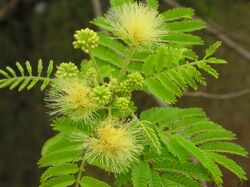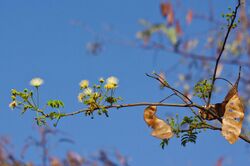Biology:Albizia amara
| Albizia amara | |
|---|---|

| |
| Scientific classification | |
| Kingdom: | Plantae |
| Clade: | Tracheophytes |
| Clade: | Angiosperms |
| Clade: | Eudicots |
| Clade: | Rosids |
| Order: | Fabales |
| Family: | Fabaceae |
| Subfamily: | Caesalpinioideae |
| Clade: | Mimosoid clade |
| Genus: | Albizia |
| Species: | A. amara
|
| Binomial name | |
| Albizia amara (Roxb.) Boiv.
| |
| Synonyms[1] | |
| |
Albizia amara is a tree in the family Fabaceae. Its range includes southern and Eastern Africa, from South Africa to Sudan and Ethiopia. It is also found in India and Sri Lanka.[2]
Description
Albizia amara is a mid-sized, deciduous tree which resembles acacia without the thorns.[3] The bark of the tree is grey in color and is grainy and scaly.[3] The leaves consist of up to 15 pairs of side stalks and the leaflets are tiny and can consist of about 15–35 pairs.[3] The flowers are whitish-yellow powder puffs with long stamens and golden pollen.[3] The pods are flat and are about 20 cm long.[3] The leaves thin out during February–March and are renewed in April.[3] The flowers are present throughout May and the fruits ripen during October and November.[3] It is a host plant for Achaea janata.[4]
Ecology
Albizia amara is intolerant of shade, and resistant to drought. In Africa it grows mainly in sandy woodlands.[2]
Albizia amara and Hardwickia binata are the dominant canopy trees in the Central Deccan Plateau Dry Deciduous Forests ecoregion of India.[5] It is also found in the Anamalai, Palani and Cardamom hills of Western Ghats and the Godavari area, the Javadi Hills of Eastern Ghats in South India.[6]
Uses
Medicinal uses
- The leaves and flowers are used for treatment of boils and ulcers. The leaf is also used for treatment of erysipelas.[7]
- Paste of leaf and rootbark is used to cure both skin diseases and poisonous bites.[8] [This journal is probably a predatory journal].
- The seeds are regarded as astringent and used in the treatment of piles, diarrhea and gonorrhea.[8]
- The flowers are used as a remedy for cough, ulcers, dandruff and malaria.[8]
- The pharmaceutical compounds of seeds and leaves has potential broad spectrum of anticancer activity.[8]
Its wood is used for construction and furniture, and as a firewood. Albizia amara provides many environmental services: control of soil erosion, wind break, shade provider. It is also an ornamental tree in urban areas. Ruminants can feed its leaves.[9]
In colonial times, in India, its "plentiful" wood was extensively used as railway fuel.[10]
Gallery
References
- ↑ "Albizia amara (Roxb.)B.Boivin". http://indiabiodiversity.org/species/show/245368/?max=8&offset=0&classification=265799&taxon=116733&view=grid.
- ↑ 2.0 2.1 "Orwa C, A Mutua, Kindt R, Jamnadass R, S Anthony. 2009 Agroforestree Database: a tree reference and selection guide version 4.0 (http://www.worldagroforestry.org/sites/treedbs/treedatabases.asp ). Accessed 18 July 2014 [1]
- ↑ 3.0 3.1 3.2 3.3 3.4 3.5 3.6 Krishen, Pradip (2006). Trees of Delhi: A Field Guide. Penguin Books India. ISBN 9780144000708. https://books.google.com/books?id=vw9IDLLkWtEC&dq=albizia+amara&pg=PA348.
- ↑ Sen-Sarma, P. K. (2012). Forest Entomology. APH Publishing. ISBN 9788131303320. https://books.google.com/books?id=I2JnsZGGYrYC&dq=albizia+amara&pg=PA2.
- ↑ Wikramanayake, Eric; Eric Dinerstein; Colby J. Loucks; et al. (2002). Terrestrial Ecoregions of the Indo-Pacific: a Conservation Assessment. Island Press; Washington, DC. pp. 324–326
- ↑ Mani, M.S (December 2012). Ecology and Biogeography in India. Springer Science & Business Media. ISBN 9789401023313. https://books.google.com/books?id=FvvtCAAAQBAJ&dq=albizia+amara&pg=PA726. Retrieved 24 October 2015.
- ↑ Khare, C.P. (22 April 2008). Indian Medicinal Plants: An Illustrated Dictionary. Springer Science & Business Media. pp. 29, 30. ISBN 9780387706375. https://books.google.com/books?id=gMwLwbUwtfkC&dq=%22albizia+amara%22&pg=PA29.
- ↑ 8.0 8.1 8.2 8.3 "Albizia amara – A Potential Medicinal Plant: A Review". International Journal of Science and Research (IJSR) 5. https://www.ijsr.net/archive/v5i3/NOV161939.pdf.
- ↑ Heuzé V., Thiollet H., Tran G., Lebas F., 2016. Albizia (Albizia amara). Feedipedia, a programme by INRA, CIRAD, AFZ and FAO. https://www.feedipedia.org/node/337
- ↑ Cox, Arthur F., 1895. Madras District Manuals: North Arcot (North Arcot District Gazetteer). Madras: Government Press. p. 25.
Wikidata ☰ Q8193696 entry
 |








